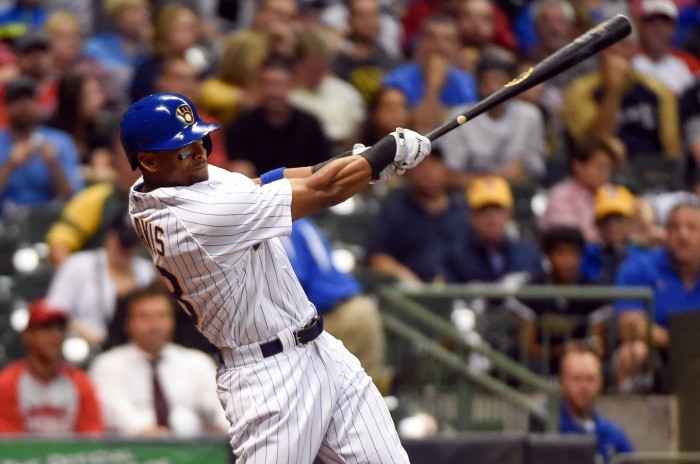At the trade deadline, the Brewers traded Gerardo Parra. Unsurprisingly, many fans were upset, as is often the case when a team trades away a quality player. What does surprise me is the negative general reaction toward Khris Davis when he returned to a starting role. The thought among those fans is that Gerardo Parra is wholly a better player than Khris Davis. However, that’s not really true. It’s unfortunate some fans remain biased against certain types of players, regardless of the objective facts at hand.
Khris Davis does three things poorly for which some fans cannot seem to forgive him. He strikes out more than the league-average player, has a low batting average, and has a poor arm. These are hindrances that Gerardo Parra does not share. That’s all the fans in question need to know in order to pass judgement and pick a favorite. But, of course, there is more to being a good baseball player. There are also ways of making up for deficiencies.
Khris Davis has two distinct advantages over Gerardo Parra — he hits for power and draws walks at an above-average rate. Take a look at their season stats side by side:
| Player | PA | AVG | OBP | SLG | wRC+ | TAv |
|---|---|---|---|---|---|---|
| Khris Davis | 416 | .246 | .322 | .508 | 120 | .284 |
| Gerardo Parra | 559 | .287 | .324 | .453 | 106 | .271 |
As you can see, Parra has a clear advantage in batting average. He beats Davis by a whopping forty-one points. But that’s the only area where Parra has a distinct advantage. He only bests Davis by two points in on-base percentage while Davis has a fifty-five point lead in slugging. In both advanced metrics — weighted runs created plus and true average — Davis comes out well ahead.
Obviously, Davis’ huge power advantage plays a large part in giving him the offensive advantage. But his greater ability to draw walks should not be ignored. He has a 10.1 percent walk rate versus Parra’s paltry 4.8 percent. Parra gets more base hits, but because of the disparity on walk rates, the two actually get on base at nearly the same rate. In other words, even though Davis doesn’t get as many base hits, he’s not making more outs than Parra.
It’s still true that Parra holds a sizable advantage defensively. But Davis’ offense comes very close to making up for his poor defense and depending on the metric allows him to surpass Parra in total value.
| Player | fWAR | rWAR | WARP |
|---|---|---|---|
| Khris Davis | 1.4 | 0.9 | 1.5 |
| Gerardo Parra | 0.6 | 1.1 | 1.7 |
FanGraphs’ WAR metric is the only one that prefers Khris Davis to Gerardo Parra. But both Baseball Reference and Baseball Prospectus have the two within 0.2 points. That’s no functional difference. It’s also important to note the disparity in playing time. Parra has 143 more plate appearances, in part because Khris Davis needed mid-season knee surgery. WAR is accumulative, meaning it can go up or down with more playing time. It’s possible with equal playing time Davis could surpass Parra in wins above replacement. Of course, the reverse is also true.
It seems many prefer Gerardo Parra because he excels in the more traditional areas — batting average, strikeout rate, and defense. Khris Davis is perceived to be a worse player than he is because many people are still biased against players with poor batting averages and high strikeout numbers. But when you use better descriptive and more encompassing statistics — OBP, wRC+, TAv, WAR — it becomes clear that the two are at the very least on equal footing with respect to overall value or wins above replacement. And Davis is objectively the superior offensive player.
